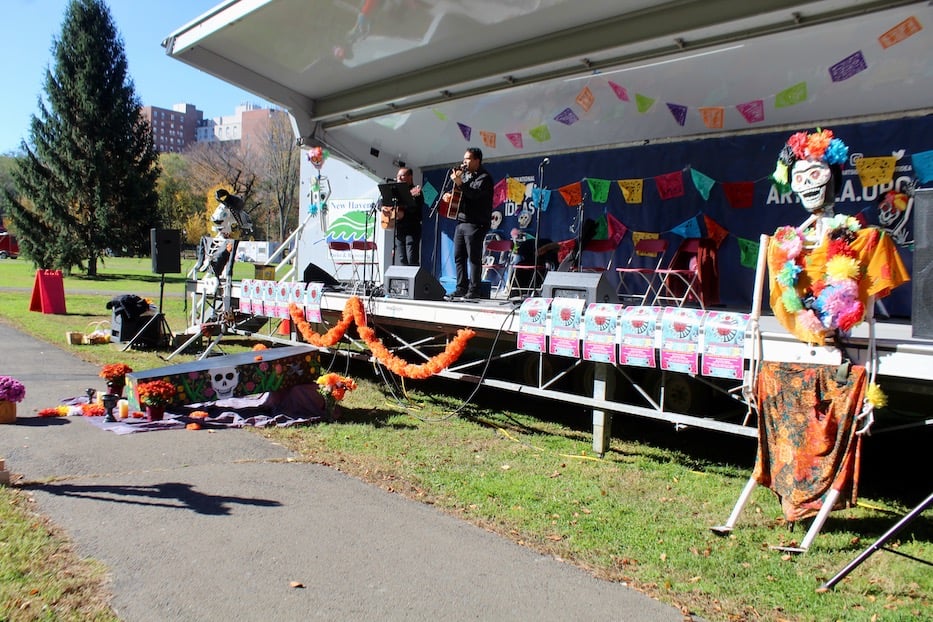
Lucy Gellman Photos.
The first notes of “Amorcito Corazón” sailed over the New Haven Green, and the crowd moved in toward the stage instinctively. In the audience, some attendees sang quietly to themselves; others pulled out their phones and began to record. On the ground, plumes of white smoke rose into the air, carrying the sweet smell of copal incense. A photograph of the late Art Perlo looked up at the blue sky, smiling. It was a day overdue, but Día de Muertos had arrived.
A traditional Tlaxcaltec observance of Día de Muertos (Day of the Dead) came to the New Haven Green Thursday afternoon, as Unidad Latina en Acción (ULA) and the International Festival of Arts & Ideas joined forces for the last Rhythm Exchange of the season. For the past three months, the festival has brought the biweekly program to the Green, with dance and musical traditions that range from Bharatanatyam to Bachata and hula to hip-hop.
In its final iteration, organizers from ULA folded in mariachi, a community ofrenda, Tlaxcaltec textile artists who are members of Culturas del Pasado, Voces del Presente, and remarks delivered in Spanish, English, and Náhuatl. There’s a synergy there: the village of San Francisco Tetlanohcan, which sits at the foot of La Malinche in Tlaxcala, became New Haven’s seventh sister city in April 2010. The women making art in the region are keeping an Indigenous culture alive.
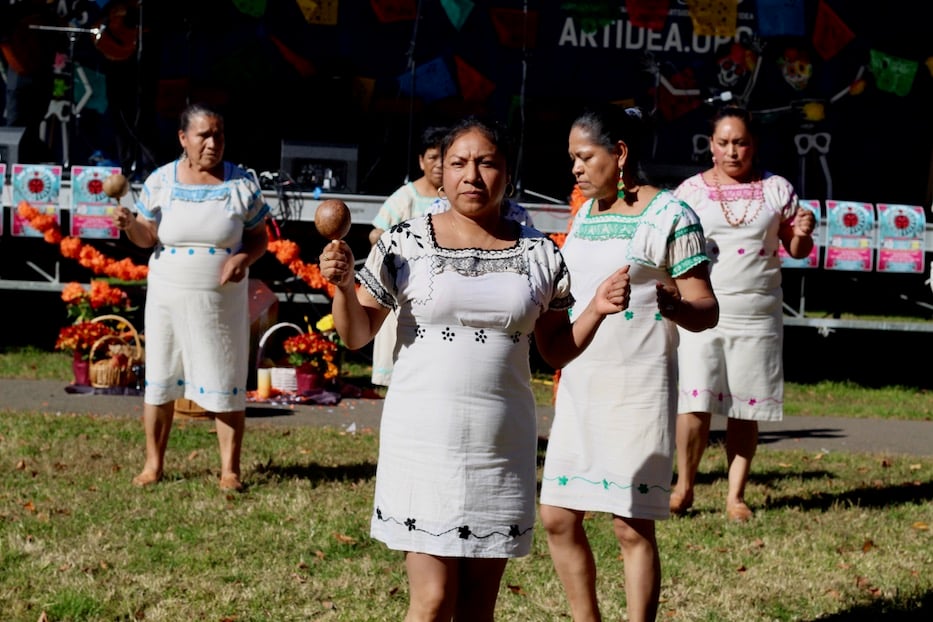
Guadalupe Celo Qualteca (front) with members of Culturas del Pasado, Voces del Presente.
“Our culture is our responsibility to continue to cultivate in this country, even far away from our origins,” said ULA organizer Nayeli Garcia, stopping every few sentences for fellow organizer Lupita Galvan Tinoco to translate. “You guys are here to be a part of this, and we thank you so much.”
On Saturday, the celebrations will continue with ULA’s 12th annual Día de Muertos parade, which kicks off at 26 Mill St. in the city’s Fair Haven neighborhood at 4 p.m. From the building, an old warehouse, ULA plans to parade through the streets of the surrounding neighborhood, paying homage to both migrants who have perished and New Haven activists George Edwards, Art Perlo, and Robin Latta.
From the beginning of the afternoon, presenters created space for attendees to both learn about Día de Muertos and to connect with the tradition, particularly for those who may have grown up observing it in their homes and with their families. In front of the stage, organizers built an ofrenda, or memorial altar, with a painted casket, garlands of orange marigolds, and portrait of Perlo, who passed away last December after a months-long fight with bladder cancer.
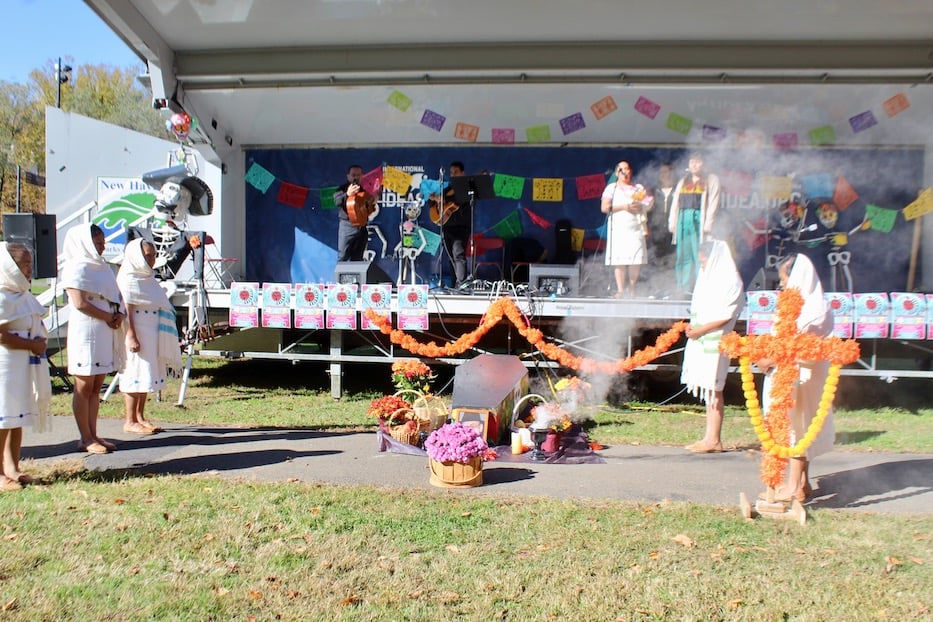 Buckets of mums and blood-red coneflowers surrounded it, yellow at the centers. A bowl of copal incense, ringed on one side by half-burned candles, made the air spiced and fragrant beside them. Nearby, a crucifix stood upright in the grass, covered in a thick coat of orange strips of paper. Orange and yellow banners hung from its head.
Buckets of mums and blood-red coneflowers surrounded it, yellow at the centers. A bowl of copal incense, ringed on one side by half-burned candles, made the air spiced and fragrant beside them. Nearby, a crucifix stood upright in the grass, covered in a thick coat of orange strips of paper. Orange and yellow banners hung from its head.
On the stage, musicians José Torralba and German Xilotl dipped into their set and pulled out “La Bruja,” a Son Jarocho standard that has as many reinterpretations as it does words. Around them, huge, soaring skeletons glinted in the sun, dressed in flower crowns, wide-brimmed hats and black matador jackets. Some stood so close to each other they almost appeared to be touching bony hands. The skeletons, which will float through the streets of Fair Haven this weekend, are the years-long work of Guatemalan artist Pedro Lopez and a team of dedicated ULA volunteers.
As Torralba and Xilotl flowed into “La Llorona,” Garcia said she was grateful for the chance to share part of her culture that she holds close. Born and raised in Tlaxcala, she and her family migrated to New Haven 11 years ago “for a better life,” she said. For years now, they have made an ofrenda for her grandparents, Antonio and Pamfilo.
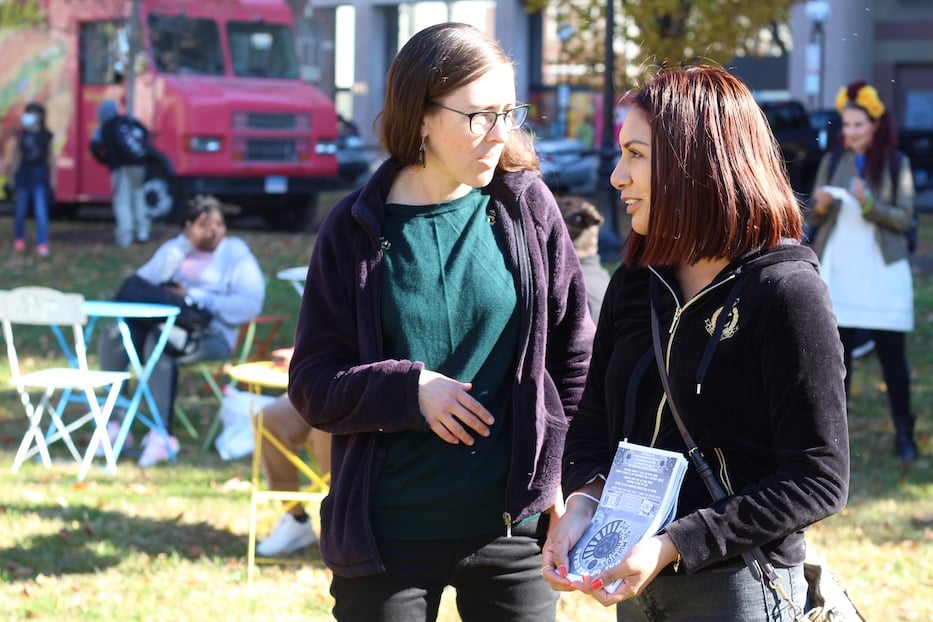
Meg Fountain and Nayeli Garcia.
Each November, they prepare it with flowers, small, domed loaves of pan de muerto, fruit, mole, Corona beer and packs of cigarettes, so that the spirits will find their way home. Then they open their doors, welcoming the spirits in. For Garcia, who was just 13 when she left home, it’s a way to keep them alive long after their physical bodies have left the earth.
“I couldn’t see them one last time,” she said of Pamfilo, who died after she and her family were in the U.S. “I really truly believe that they are here, that they come back. I try to let them know that I miss them.”
While community altars have become more common in New Haven in recent years—on the Green, in neighborhoods, and at restaurants for instance—Tinoco noted that it’s still fairly rare to see a display like Thursday’s. Born and raised in Austin, she grew up observing Day of the Dead with her parents. After time in Houston, she moved to New Haven last year to pursue a graduate degree in public health at Yale. She and a roommate have an ofrenda in their home.
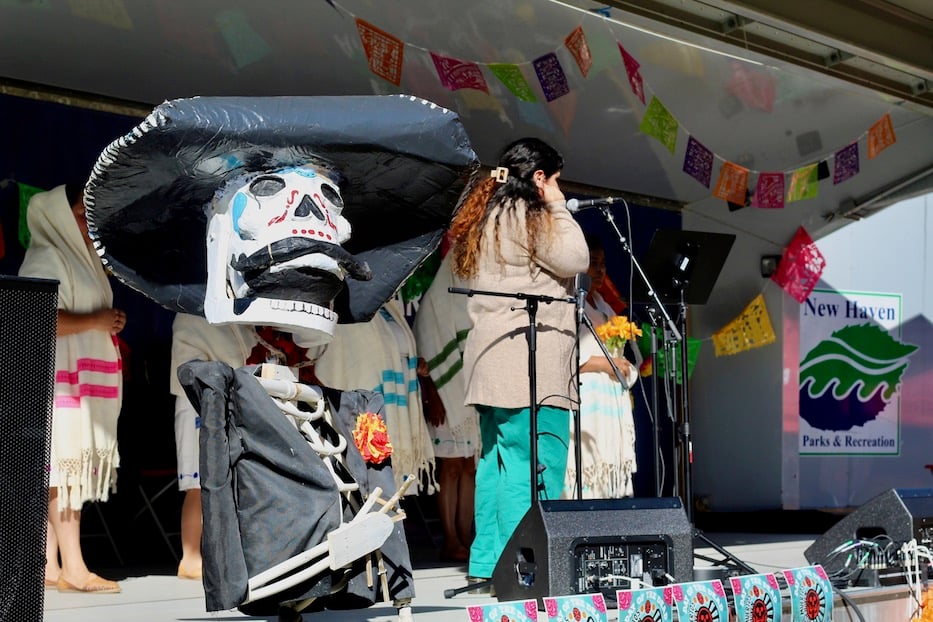
“Oftentimes I think sharing of culture is pretty intimate in our homes,” she said—but she likes the idea of a communal space to both remember and welcome back the ancestors. This year, she is honoring her grandparents, Ignacio Galvan and Maria Guadalupe Ramirez.
Back by the stage, members of Culturas del Pasado, Voces del Presente bridged the 2,600 miles between New Haven and Tlaxcala with ritual, dance, and song. As Torralba and Xilotl played, the group’s six women slowly surrounded the casket, sprinkling it with flower petals in the shape of a crucifix. When they pulled away, they stood around it with reverence, as if they were keeping watch.
Even in the intimacy of the moment—these six living bodies, carrying the weight and memory of the dead—they talked the audience through each motion, opening a door to Tlaxcala and to a tradition that predates colonial presence in Mexico.
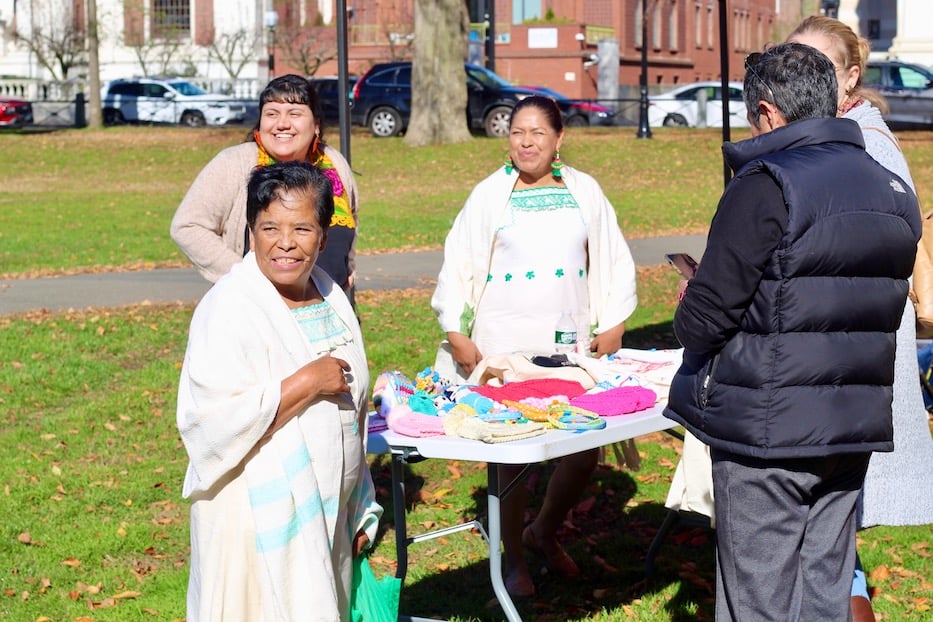
Clockwise: Carmen Gonzales, Lupita Galvan Tinoco, Laura Rodriguez Hernandez.
Music pumped through a speaker system, and dancers pulled back to both sides, leaving Carmen Gonzales in the center. Looking straight out in front of her, she lifted the incense into the air, trails of smoke rising above her. On both sides, her fellow dancers began to move slowly, Gonzales making her way forward as the vocals lifted and sailed.
As she made her way back from the stage, Laura Rodriguez Hernandez told the story of her work to preserve culture through her clothes, hand-stitched with thick, brilliant green thread that glowed against cream-colored cotton. The youngest of nine children raised in San Luis Teolocholco, Tlaxcala, Rodriguez Hernandez began to learn traditional embroidery as a girl, and took it up full time after high school.
Originally, “it was a way to live,” she said, speaking in Spanish as ULA’s Meg Fountain translated. “It was our daily bread.” As she deepened her craft, it became a way to share Náhuatl culture, language and traditions through her work. The deep green color and shape, for instance, is meant to signify both nature and el Cempasuchil—the marigold, or flower of the dead.

Her work led her to New Haven, where she is visiting this month. Two years ago, ULA members found her through Facebook—she had posted about the gifts she gives away each year to kids who are living on the street—and invited her to the city. After filing paperwork for a passport, she was finally able to come.
“I am grateful to God that I was given the opportunity to come,” she said. Each year, she observes Día de Muertos at home, welcoming back her father Julian and mother Rafaela. On her ofrenda, she said, she has bread, seeds, chocolate, pumpkin candies, sweet potatoes and Pulque ready for them. “We shout,” and they arrive, she said.
Truman School Spanish teacher Liza Taracena Bowen, who brought her students out to the event, praised both ULA and the Festival for bringing the tradition to the heart of New Haven.
Beyond her love for arts and culture, she said, she was thrilled that her students were seeing a tradition that now means so much to New haven. For her, Thursday’s presentation and music were much more powerful than something her students might see in a movie or read about in a textbook.
“It stays with them forever,” she said.
ULA will hold its 12th annual Día de Muertos festival and parade at 26 Mill St. on Saturday, Nov. 5. Face painting starts at 4 p.m. and the parade through Fair Haven begins at 6 p.m. For more from Thursday's Rhythm Exchange, check out the Arts Council's Facebook or Instagram.